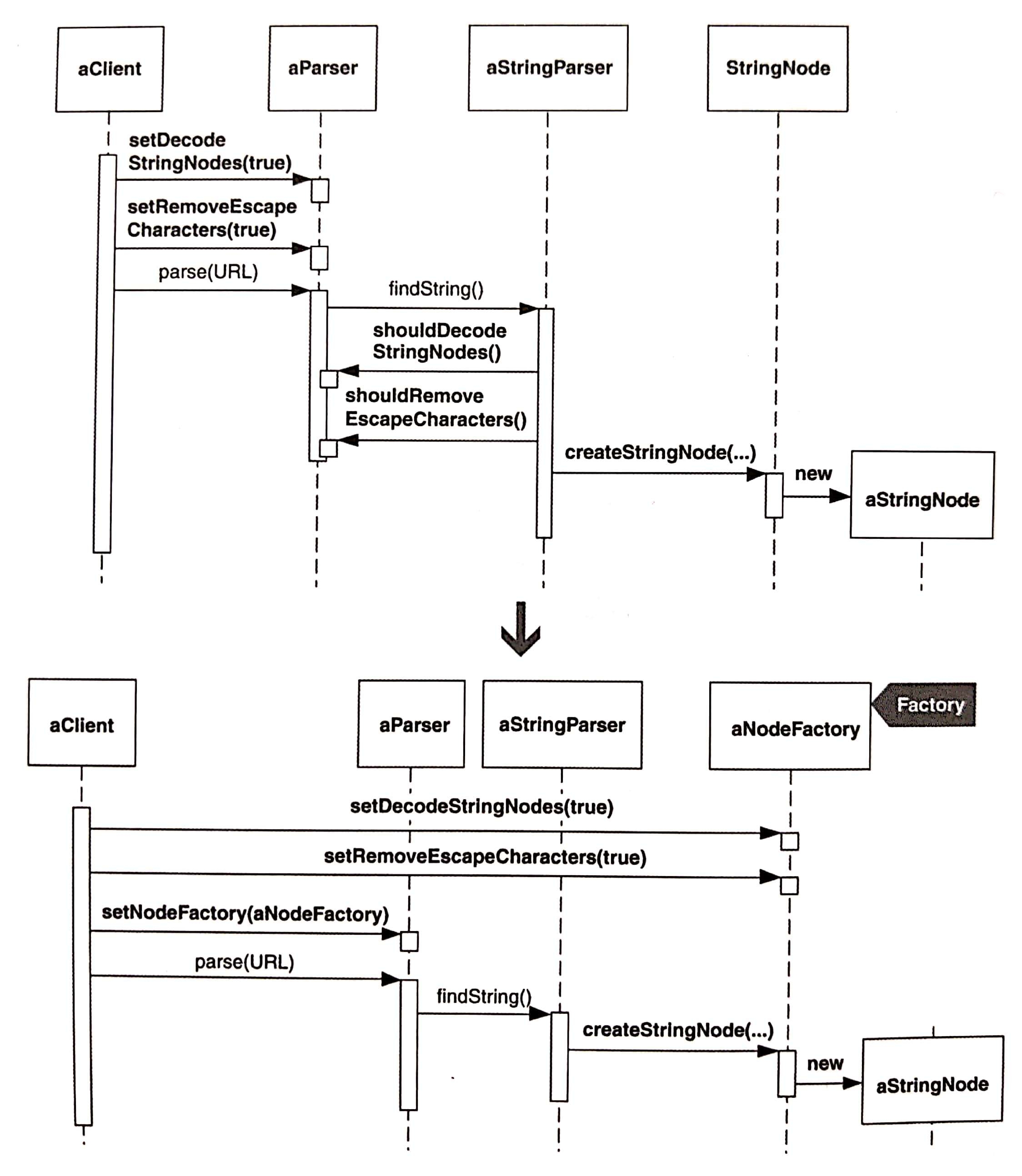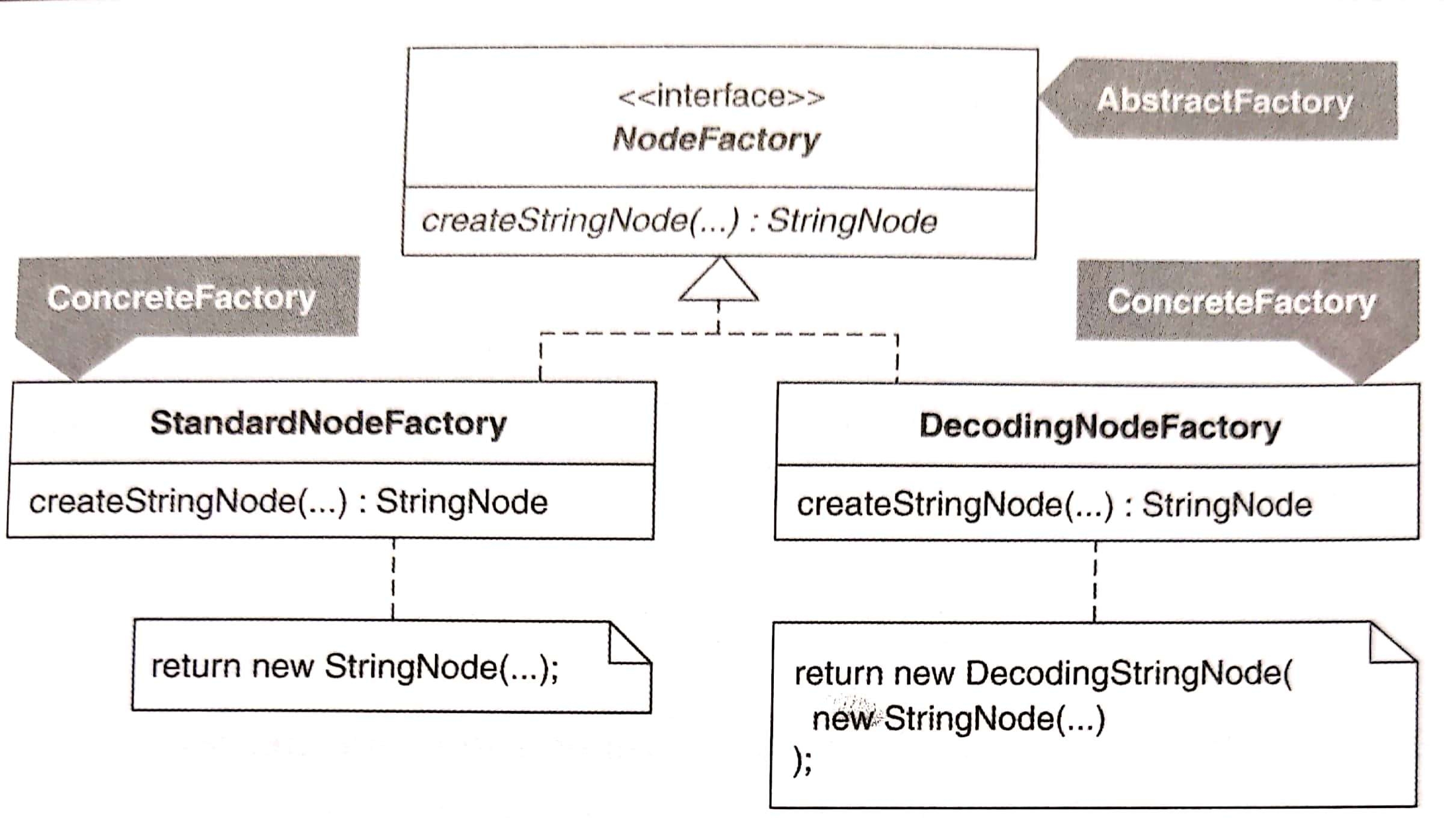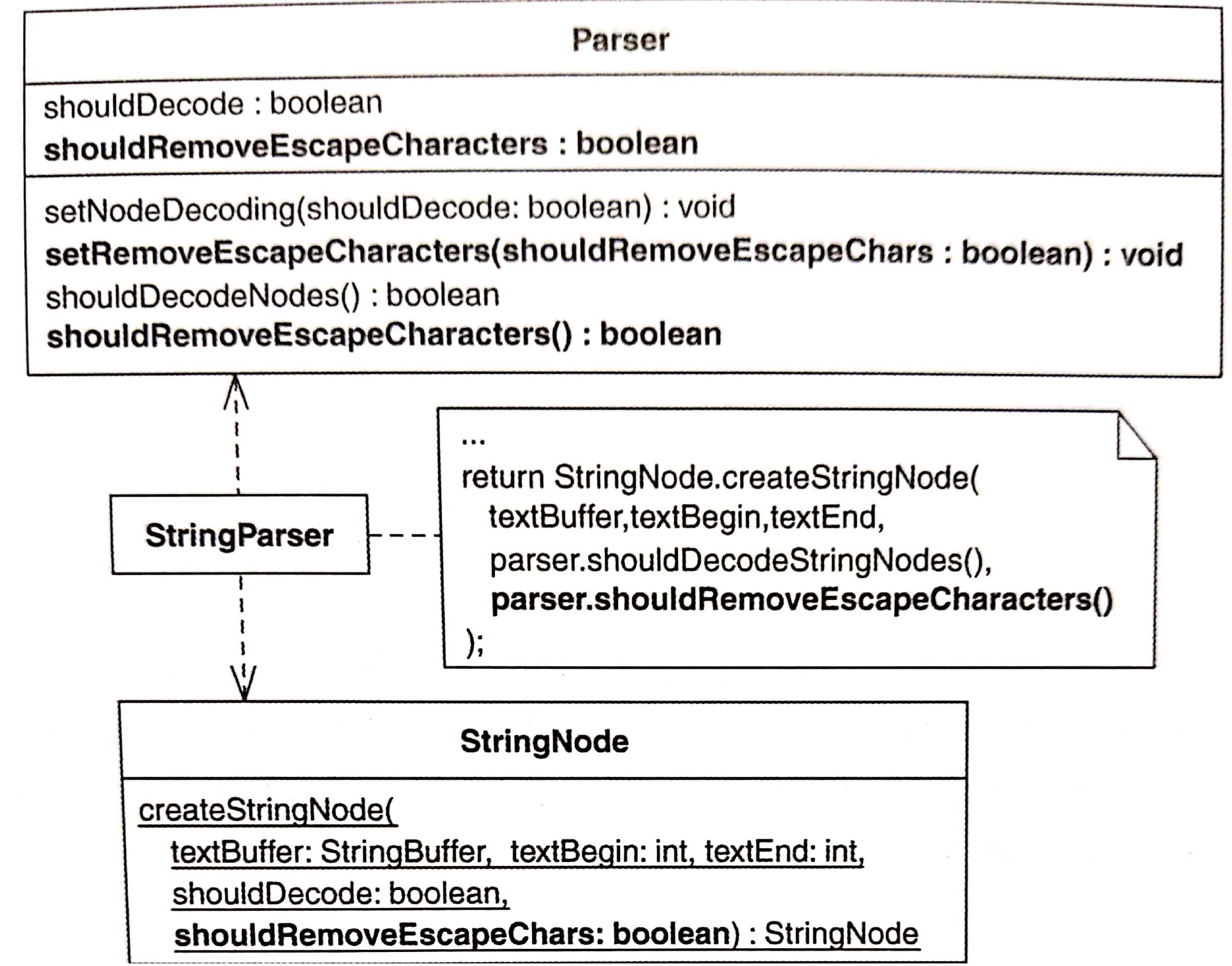# Move Creation Knowledge to Factory
把創建知識(creation knowledge)搬到 Factory。

# 動機
如果物件的創建知識分散在多個 classes 內,便會出現 Creation Sprawl(創建碼蔓生):
不該在物件創建過程中扮演任何角色的 classes,其內出現創建職責(creational responsibility)。
- e.g. 客戶使用 configure 物件,但又無法存取 creation code
- 解法:將 configure 物件傳入某個物件,再讓該物件傳入 creation code...但造成兩者相隔很遠。
Factory:以單一 class 封裝 creation 邏輯和 configure。

Factory 不必要用具體類別,也能用抽象類別。

優點
- 可以整合 creation 邏輯和 configure
- 將客戶端和 creation 邏輯解耦
缺點
- 比直接創建更複雜一點
# 作法
假設此 Factory 決定被實作成單一 class 而非 interface。
- 所謂的 instantiator 是一個「與其他 classes 合作具現出某個 product」的 class。如果 instantiator 沒有使用 creation method 來具現 product,就修改它。若有需要也請修改 product class,讓具現過程透過 creation method 發生。
- 編譯並測試
- 產生一個即將成為 Factory 的 class。
- 編譯
- 使用 Move Method 把 creation method 移至 Factory。
- 編譯
- 令 instantiator 改而具現 Factory,然後呼叫 Factory 獲得一個 class 實體。
- 編譯並測試 instantiator 是否運作正常
- 把其他 classes 使用的都搬到 Factory,修改具現者和具現點
# 範例
HTML Parser

第一步是應該讓
StringParser以 creation method 創建StringNode物件,但StringParser已經這麼做了。public class StringParser... public Node find(...) { ... return StringNode.createStringNode( textBuffer, textBegin, textEnd, parser.shouldDecodeNodes( )); } public class StringNode... public static Node createStringNode( StringBuffer textBuffer, int textBegin, int textEnd, boolean shouldDecode) { if (shouldDecode) return new DecodingStringNode( new StringNode(textBuffer, textBegin, textEnd) ); return new StringNode(textBuffer, textBegin, textEnd); }1
2
3
4
5
6
7
8
9
10
11
12
13產生一個新的 Factory class
public class NodeFactory { }1
2Move
public class NodeFactory { public static Node createStringNode( StringBuffer textBuffer, int textBegin, int textEnd, boolean shouldDecode) { if (shouldDecode) return new DecodingStringNode( new StringNode(textBuffer, textBegin, textEnd)); return new StringNode(textBuffer, textBegin, textEnd); } } public class StringNode... // public static Node createStringNode1
2
3
4
5
6
7
8
9
10
11修改
StringParser讓他具現NodeFactory,再由NodeFactory建立一個StringNodepublic class StringParser... public Node find(...) { ... NodeFactory nodeFactory = new NodeFactory(); return nodeFactory.createStringNode( textBuffer, textBegin, textEnd, parser.shouldDecodeNodes() ); }1
2
3
4
5
6
7將來自其他 classes 的創建碼移到
NodeFactory。這裡的 class 是Parser,因為建立StringNode物件時,StringParser會呼叫Parser來傳遞參數給NodeFactory:public class StringParser... public Node find(...) { ... NodeFactory nodeFactory = new NodeFactory(); return nodeFactory.createStringNode( textBuffer, textBegin, textEnd, parser.shouldDecodeNodes() ); }1
2
3
4
5
6因此,我們想把以下的
Parser移到NodeFactory:public class Parser... private boolean shouldDecodeNodes = false; public void setNodeDecoding(boolean shouldDecodeNodes) { this.shouldDecodeNodes = shouldDecodeNodes; } public boolean shouldDecodeNodes() { return shouldDecodeNodes; }1
2
3
4
5
6
7
8但是,我們不能只是把這些程式碼移過去,因為他們的客戶是 parser 的客戶,這些客戶呼叫
Parser的各種函式來設定 parser,除此之外NodeFactory甚至不能直接被 parser 客戶端使用,因為NodeFactory是由StringParser具現出來的,他本身不能直接被 parser 的客戶使用。為此,我們執行以下步驟:在「我希望它們最終與
NodeFactory合併」的那些Parser程式碼使用 Extract Class [F] 來創造出StringNodeParsingOption:public class StringNodeParsingOption { private boolean decodeStringNodes; public boolean shouldDecodeStringNodes() { return decodeStringNodes; } public void setDecodeStringNodes(boolean decodeStringNodes) { this.decodeStringNodes = decodeStringNodes; } }1
2
3
4
5
6
7
8
9這個新的 class 取代原本的 getter/setter:
public class Parser.... private StringNodeParsingOption stringNodeParsingOption = new StringNodeParsingOption(); // private boolean shouldDecodeNodes = false; // public void setNodeDecoding(boolean shouldDecodeNodes) { // this.shouldDecodeNodes = shouldDecodeNodes; // } // public boolean shouldDecodeNodes() { // return shouldDecodeNodes; // } public StringNodeParsingOption getStringNodeParsingOption() { return stringNodeParsingOption; } public void setStringNodeParsingOption(StringNodeParsingOption option) { stringNodeParsingOption = option; }1
2
3
4
5
6
7
8
9
10
11
12
13
14
15
16現在,讓
Parser客戶端具現並組態StringNodeParsingOption實體,再把那個實體傳入 parser,用來開啟StringNode的 decoding 功能:class DecodingNodeTest... public void testDecodeAmpersand() { ... StringNodeParsingOption decodeNodes = new StringNodeParsingOption(); decodeNodes.setDecodeStringNodes(true); parser.setStringNodeParsingOption(decodeNodes); parser.setNodeDecoding(true); ... }1
2
3
4
5
6
7
8
9同時
StringParser也改用上面新的 class 取得StringNode的 decoding option 狀態:public class StringParser... ... public Node find(...) { NodeFactory nodeFactory = new NodeFactory(); return nodeFactory.createStringNode( textBuffer, textBegin, textEnd, parser. getStringNodeParsingOption().shouldDecodeStringNodes() ); }1
2
3
4
5
6使用 inline 合併
NodeFactory和StringNodeParsingOption:public class StringParser... public Node find(...) { ... return parser.getStringNodeParsingOption().createStringNode( textBuffer, textBegin, textEnd // , parser.getStringNodeParsingOption().shouldDecodeStringNodes() ); } public class StringNodeParsingOption... private boolean decodeStringNodes; public Node createStringNode( StringBuffer textBuffer, int textBegin, int textEnd , // boolean shouldDecode ) { if (decodeStringNodes) return new DecodingStringNode( new StringNode(textBuffer, textBegin, textEnd)); return new StringNode(textBuffer, textBegin, textEnd); }1
2
3
4
5
6
7
8
9
10
11
12
13
14
15
16
17
18最後一步是 rename:
// public class StringNodeParsingOption... public class NodeFactory ... public class Parser... private NodeFactory nodeFactory = new NodeFactory(); public NodeFactory getNodeFactory() { return nodeFactory; } public void setNodeFactory(NodeFactory nodeFactory) { this.nodeFactory = nodeFactory; }1
2
3
4
5
6
7
8
9
10
11